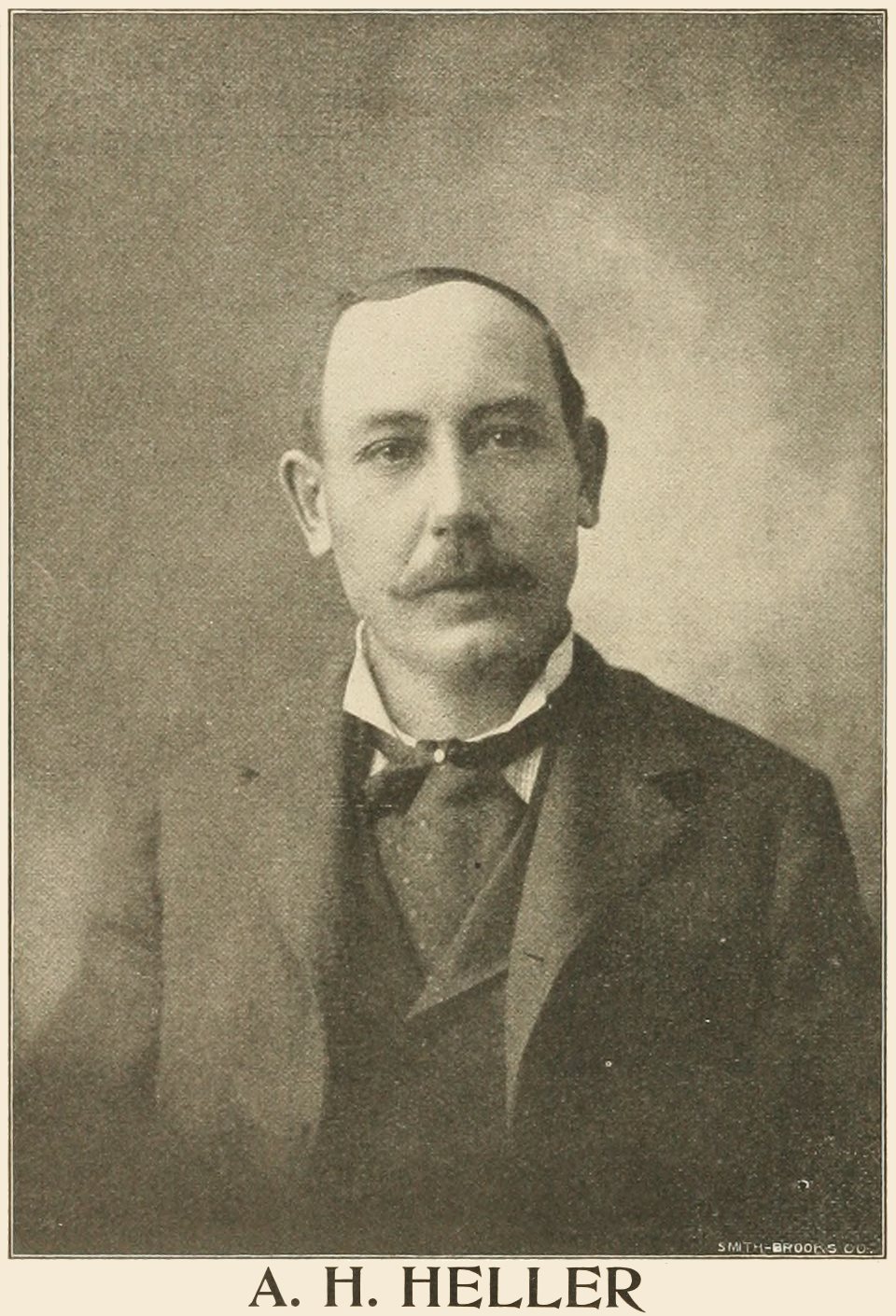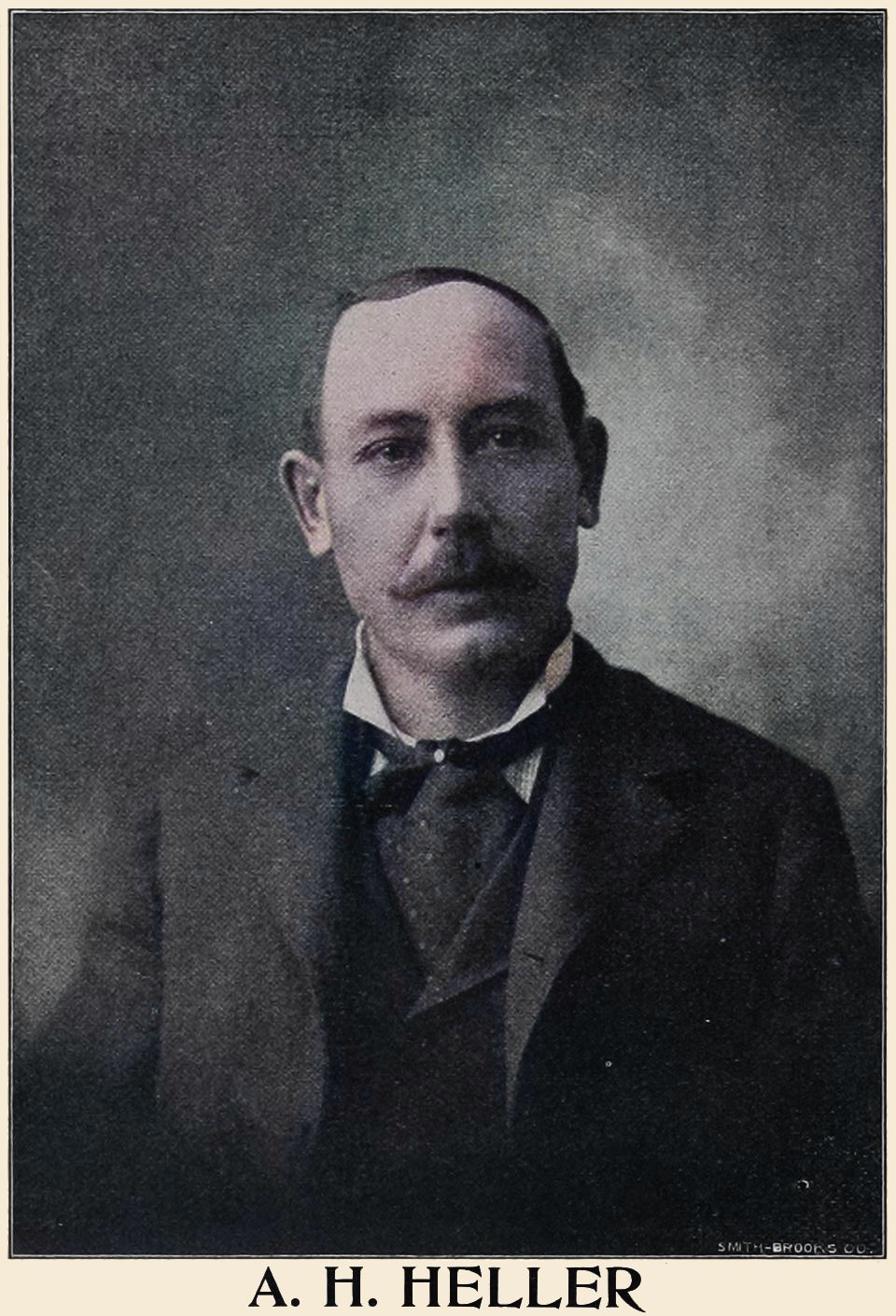-> My Collection, Also on
-> the Internet Archive Site; Link to article.
New Year Edition 1903
(pages 72-73)
Source had two pics and I added 2 extra pics from my collection
Among the men who have contributed largely to the ultimate success and glory of the Cripple Creek gold fields A. H. Heller is entitled to a considerable amount of praise.
Like Captain De la Mar, of Utah, who opened the era of treating the extremely low grade ores of the Mercur fields, Mr. Heller demonstrated to the world at large that all the low grade oxidized ore of the Cripple Creek district could be treated, and to a handsome profit on the aggregate.
A few years ago engineers and chemists alike were of the opinion that the cyanide process was a thing of the past, that it was no longer applicable or adapted to the Cripple Creek ores.
The mills, one by one, ultimately closed and remained, to some, as eye sores.
All through these years thousands of tons of low grade oxidized ore was accumulating on the various hillsides. Many methods and processes were tried, but all failed.
Knowing ones said that the gold contained in the rock was beyond the recovery of mortals. It was beyond the recovery of all but A. H. Heller. He was the only man who did not think so, or allow himself for one minute to believe that it could not be recovered.
After Mr. Heller arrived here he spent some time prospecting around the hills. There was hardly a dump that was not sampled. The assays were arranged for each dump and the total value of the gold contents were estimated.
Samples of this and that dump were taken away. In a laboratory Mr. Heller spent some weeks determining which ore was adapted to the cyanide process, how much cyanide it would take per ton of rock to leach the precious yellow metal, and the cost.
After acquiring all data necessary he erected an experimental mill on Ironclad hill.
Mr. Heller leased the old Arequa mill, below the Elkton mine. There on a commercial scale he demonstrated the feasibility of treating, to a profit, the very low grade ores of the camp.
He purchased the dump of the Ironclad mine. The average grade of the ore was around $5.00 to the ton. Notwithstanding that it was hauled all the way to the mill, at quite an expense, a profit was derived from the treatment.
Realizing that a greater profit could be made from the Ironclad ore if there was a mill on the ground, Mr. Heller constructed one. The first clean up resulted in a gold brick that weighed close to seventy ounces of gold, which was purchased at the branch mint of Uncle Sam in Denver.
On the Ironclad the ore is hoisted from varying depths, from the surface down. The ore is soft in texture and porous and only required going over the screens. Leaching was accomplished in little time. The cost of mining and milling was reduced to $2.00 per ton. As an extraction of 85 per cent, of the gold contents was made, it is readily seen that with an ore containing values of $5.00 to the ton, the profit was $1.20 per ton.
The Ironclad mill was a success. Immediately negotiations were opened with Mr. Heller for the plant and lease on the property, W. G. Rice and W. O. Temple of Cripple Creek securing it.
Such a demonstration opened the eyes of the mining men of the district. It was food for mental speculation. Every one commenced to study the cyanide question. Naturally Mr. Heller was consulted by many and to his credit it must be said that in each and every case he has fully posted every one and cheerfully given them any information they have asked for.
He is public spirited and desires to see the welfare of the district promoted as much as possible and has gone out of his way more than once to help people in various ways.
With the old Arequa mill running full blast, people no longer doubted the feasibility of marketing their low grade ore and Mr. Heller was prevailed upon to accept custom work. Before that he had been treating only such ore as he could purchase, and many a dump was cleaned away and the gold contents recovered where they amounted to less than $5.00 to the ton in gold.
He then began taking custom work, which meant an outlet for thousands of tons of low grade ore.
Late in the fall Mr. Heller purchased the huge dump of the Wild Horse mine, belonging to the United Gold mines. It is estimated that there is close to 21,000 tons of rock in it that will average $6.00 to the ton. The rock is hauled by wagon down to the mill and he is treating at the rate of seventy-five tons each day.
In proving that this low grade ore could be handled and a profit derived both by the mining company and himself, the achievement has contributed more largely to the district's welfare than has any other in the last five years.
Profiting by his experience many men have started the work of erecting cyanide plants in the district, and before many months go by there will be quite a number of plants in successful operation, the gold output of which will materially help to swell the annual golden stream of wealth for which Cripple Creek is famed throughout the civilized world.
Mr. Heller is an engineer of ability and ingenuity, which is conclusively evidenced during the past year by what he has done.




-colored.jpg)